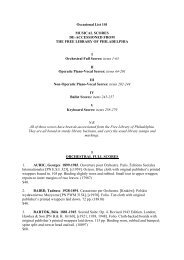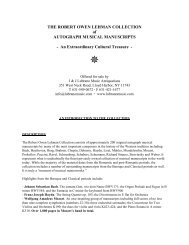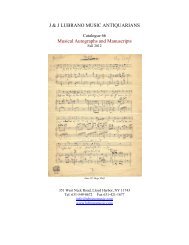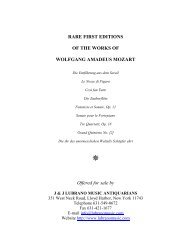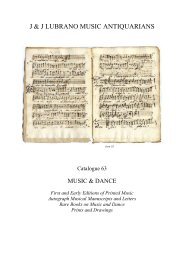17th Century Italian Vocal Music - J & J Lubrano, Music Antiquarians
17th Century Italian Vocal Music - J & J Lubrano, Music Antiquarians
17th Century Italian Vocal Music - J & J Lubrano, Music Antiquarians
Create successful ePaper yourself
Turn your PDF publications into a flip-book with our unique Google optimized e-Paper software.
J & J LUBRANO MUSIC ANTIQUARIANS<br />
17 th <strong>Century</strong> <strong>Italian</strong> <strong>Vocal</strong> <strong>Music</strong><br />
In Original Editions and Contemporary Manuscripts<br />
351 West Neck Road, Lloyd Harbor, NY 11743<br />
Telephone 631-549-0672 Fax 631-421-1677<br />
E-mail info@lubranomusic.com<br />
www.lubranomusic.com
EXHIBITIONS<br />
We will be exhibiting a selection of our stock at the following venues and look forward to seeing you<br />
there should you have the opportunity to attend:<br />
March 21-24, 2010<br />
MUSIC LIBRARY ASSOCIATION MEETING<br />
Paradise Point Resort<br />
1404 Vacation Road<br />
San Diego, CA<br />
April 8-10, 2010<br />
NEW YORK ANTIQUARIAN BOOK FAIR<br />
Park Avenue Armory<br />
Park Avenue & 67 th Street<br />
New York, NY<br />
April 11, 2010<br />
PROFESSIONAL AUTOGRAPH DEALERS’ ASSOCIATION SHOW<br />
Park Lane Hotel<br />
36 Central Park South<br />
New York, NY<br />
CONDITIONS OF SALE<br />
Please order by item number, composer/author and title, or by inventory number (found in parentheses,<br />
preceding each item’s price). To avoid disappointment, we suggest a telephone call, fax or e-mail to<br />
reserve items of special interest.<br />
Prices in this catalogue are net. Postage and insurance are additional. An 8.625% sales tax will be<br />
added to the invoices of New York State residents.<br />
Overseas customers are asked to kindly remit in U.S. funds (drawn on a U.S. bank), by international<br />
money order, or by international bank wire transfer, inclusive of all bank charges (please inquire for<br />
further details).<br />
Items remain the property of J & J LUBRANO MUSIC ANTIQUARIANS LLC until paid for in full.<br />
YOUR COLLECTING INTERESTS<br />
We invite you to advise us of your most current and specific collecting interests to better enable us to<br />
direct our most relevant offers and catalogues to you<br />
FINE ITEMS & COLLECTIONS PURCHASED
PRINTED MUSIC<br />
1. AGAZZARI, Agostino ?1579-81 -1641-42<br />
Armonici Intronati Sacre Cantiones, Binis, Ternisq[ue], Vocibus concinendae. Liber Quartus.<br />
Cum Basso ad Organum. [Cantus 2 part]. Rome: Antonio Soldi, 1620.<br />
Small quarto. Contemporary carta rustica wrappers. 1f. (r. title, v. dedication), 15ff. printed<br />
music with index to verso of final leaf. Title printed within woodcut border with additional<br />
central woodcut device. <strong>Music</strong> printed typographically in diamond-head notation. Decorative<br />
woodcut initials throughout. With early ownership signature to title and early manuscript<br />
titling to wrappers. Wrappers slightly worn and soiled with small areas of dampstaining.<br />
Some foxing; corners slightly creased; minor chipping to edges; lower outer corners<br />
dampstained throughout. In very good condition overall.<br />
RISM A349 (one copy of the bass part only, in the Biblioteca dell' Accademia <strong>Music</strong>ale<br />
Chigiana in Siena). Gaspari II, p. 334.<br />
"Agazzari’s parents were evidently of Sienese origin, and he himself went to Siena as a boy<br />
and received his training there, perhaps from Francesco Bianciardi. He was organist at Siena<br />
Cathedral from 1597 to 1602, when he left to direct the music at the Collegio Germanico,<br />
Rome (1602-3). In 1604 he attended the reopening of the Sienese Accademia degli Intronati.<br />
By 1606 he was maestro di cappella at the Seminario Romano, but returned to Siena in 1607<br />
after being blacklisted by the Cappella Sistina. In the following years he was organist at<br />
Siena Cathedral on three different occasions: in 1609, 1611-17 and 1629-33; he also served<br />
for two short periods as music director at S Maria di Provenzano, Siena, 1617-19 and 1620-
?1622. Not until February 1641 was he appointed maestro di cappella at Siena Cathedral,<br />
and failing health forced him to resign the position the following September. He died in<br />
January 1642 and was buried in S Niccolò del Carmine".<br />
"Agazzari's contributions made him much more than the leading Sienese composer of the <strong>17th</strong><br />
century. A champion of the 'new style' of sacred music, he injected fresh vitality into the<br />
small-scale motet and spurred its development in Rome. His influence extended beyond the<br />
Alps: many of his works appeared in northern anthologies, and his basso continuo treatise<br />
served as the basis for Michael Praetorius's discussion of the same subject in the Syntagma<br />
musicum." Coleen Reardon in Grove online. (19155)<br />
$3,800.<br />
2. ANTONELLI, Abbundio ? - ca. 1629<br />
Liber Secundus Diversarum Modulationum Binis, Ternis, Quaternis, ac Quinis vocibus.<br />
Auctore Abundio Antonellio Metropolitanae Capellae Beneventanae moderatore. [Cantus<br />
Secundus and Altus parts]. Rome: Bartholomeo Zannetti, 1616.<br />
2 volumes. Small quarto. Contemporary carta rustica wrappers.<br />
Cantus Secundus: 1f. (r. title, v. dedication), 3-23 printed music, [i] (index) pp.<br />
Altus: 1f. (r. title, v. dedication), 3-14 printed music, [i] (index), [i] (blank) pp.
Titles printed within woodcut border with additional central woodcut device. <strong>Music</strong> printed<br />
typographically in diamond-head notation. Decorative woodcut initials throughout. With early<br />
ownership signature to titles and early manuscript titling to wrappers. Wrappers slightly worn;<br />
several small stains; small hole to spine of Cantus Secundus part. Some leaves very slightly<br />
creased and chipped. In very good condition overall.<br />
First Edition. RISM A1272 (no copies of any parts outside Italy). According to RISM, there<br />
are no holdings of any works of this composer in American, British or French libraries.<br />
Antonelli, born in Fabrica near Viterbo, was a composer and teacher. "According to Casimiri<br />
he must have taught music at the Seminario Romano, Rome, some time between 1602 and<br />
1606. The first post he held that is specifically documented is that of maestro di cappella of S<br />
Giovanni in Laterano, Rome, where he is recorded from 1 June 1611 to 20 July 1613... The<br />
title-pages and dedications of works that Antonelli published in 1614 and 1615 indicate that<br />
he was then maestro di cappella of Benevento Cathedral. That he had returned to Rome by<br />
February 1616 can be determined from the dedication of his print of that year... Antonelli<br />
probably remained in Rome for the rest of his life..."<br />
"Antonelli was primarily a composer of sacred works, most with continuo, which are typical<br />
products of the early <strong>17th</strong>-century Roman school. The masses and many of the motets tend to<br />
be conservative, with mainly contrapuntal - frequently canonic- textures. Greater textural,<br />
harmonic and melodic diversity is to be found in the three books of 1615-16. These include<br />
pieces in which strict counterpoint or freely imitative two-part writing predominates and<br />
others in which solo and choral passages alternate." Patricia Ann Myers in Grove online.<br />
(19157)<br />
$7,000.<br />
3. CIFRA, Antonio 1584-1629<br />
Motecta, et Psalmi, Duodenis Vocibus, Una cum Basso ad Organum. Auctore Antonio Cifra<br />
Almae Docus Lauretanae <strong>Music</strong>ae Praefecto Nunc primùm in lucem aedita. [Cantus 1, Cantus<br />
2, Tenor, Bass, Bassus et organum parts]. Venice: Alessandro Vincenti, 1629.<br />
5 volumes. Small quarto. Contemporary carta rustica wrappers.<br />
Cantus Primi Chori: 1f. (r. title, v. dedication), 25 [!29] printed music, [i] (index) pp.<br />
Cantus Sec. Chori: 1f. (r. title, v. dedication), 25 printed music, [i] (index) pp.<br />
Tenor Tertii Chori: 1f. (r. title, v. dedication), 21 printed music, [i] (index) pp.<br />
Bassus Tertii Chori: 1f. (r. title, v. dedication), 21 printed music, [i] (index) pp.<br />
Bassus ad Organum: 1f. (r. title, v. dedication), 17 printed music, [i] (index) pp.<br />
Titles printed within woodcut borders with additional central woodcut device. <strong>Music</strong> printed<br />
typographically in diamond-head notation. Decorative woodcut initials throughout. With early<br />
ownership signature to titles and early manuscript titling and coat of arms to wrappers.<br />
Wrappers slightly worn and soiled; very occasional foxing and staining; several leaves with<br />
minor worming to blank margins; some parts loose in wrappers; bassus part unbound. Minor<br />
creasing and soiling. Very good, crisp, wide-margined copies overall.<br />
First Edition. RISM C2208 (one complete copy and one single part only recorded; no copies<br />
in the U.S. or Great Britain).<br />
"Despite his principal appointment at Loreto and the size of his secular output, Cifra was<br />
essentially a member of the Roman school of church composers, together with men such as<br />
Gregorio Allegri, Paolo Agostini and Benevoli. (Loreto, as a centre of pilgrimage, had strong<br />
connections with Rome, and the musical director there was normally a Roman.) He was by<br />
far the most prolific composer of this school in the early <strong>17th</strong> century. His sacred music is
dominated by eight books of concertato motets for two to four voices and organ, some of<br />
which were popular enough to run into several editions, but it also includes two volumes of<br />
masses as well as a number of motets, psalms and litanies for two or three choirs. The<br />
number of his motets published in German anthologies at the time makes him the most<br />
important ambassador there of the Roman style. His secular output is divided almost equally<br />
between five-part madrigals and scherzi for smaller forces and basso continuo." Jerome<br />
Roche in Grove online. (19158)<br />
$18,500.<br />
4. FERRETTI, Giovanni ca. 1540-after 1609<br />
Il Primo [Secondo, Tertia] Libro delle Canzoni, Alla Napolitana a Cinque Voci. Novamente<br />
ristampate. [Alto and Tenore parts]. Venice: Girolamo Scotto, 1582, 1581, 1575.<br />
6 volumes bound in 2. Small quarto. Contemporary limp vellum.<br />
Alto:<br />
I: 1f. (r. title, v. blank), 3-23, [i] (index) pp.<br />
II: [1] (title), 2-23 printed music, [i] (index) pp.<br />
III: [1] (title), 2-23 printed music, [i] (index) pp.<br />
Tenore:<br />
I: 1f. (r. title, v. blank), 3-23 printed music, [i] (index) pp.<br />
II: [1] (title), 2-23 printed music, [i] (index) pp.<br />
III: [1] (title), 2-23 printed music, [i] (index) pp.
With decorative woodcut headpiece and attractive large woodcut device to titles. <strong>Music</strong><br />
printed typographically in diamond-head notation. Decorative woodcut initials throughout.<br />
With early ownership signature and additional early annotation crossed out to titles of both<br />
parts of Book I, early manuscript titling to binding. Bindings slightly worn; several small<br />
holes and stains. Some worming to lower portion of alto part, occasionally just affecting text;<br />
occasional foxing, soiling and dampstaining; several leaves lightly browned. In very good<br />
condition overall.<br />
Book I: New Vogel 945. RISM F517 (no copies in the U.S.). Book II: New Vogel 950. RISM<br />
F522 (no copies in the U.S.). Book III: New Vogel 953. RISM F525 (no copies in the U.S.).<br />
"Originally from Liège, Giovanni Ferretti moved south to Italy. He lived in Ancona from 1569<br />
until 1580, and became maestro di cappella of the cathedral some time between 1573 and<br />
1575... Ferretti is mainly known for his canzoni for five and six voices, a form that developed<br />
into the later canzonetta... He was the first composer to expand the number of voices of the<br />
canzone alla napolitana from four to five and even six voices." Bernstein: <strong>Music</strong> Printing in<br />
Renaissance Venice The Scotto Press (1539-1572), no. 283.<br />
"Ferretti's most successful and influential works were his early napolitane, which enjoyed a<br />
popularity north of the Alps rivalled perhaps only by Marenzioís lighter pieces and Gastoldi's<br />
five-voice ballettos... Ferretti's napolitane, particularly the early books, were reprinted and<br />
admired in Antwerp, Nuremberg and especially England. If, as Kerman has suggested, the<br />
crucial influence of Morley on the English madrigal is in effect the influence of the classic<br />
<strong>Italian</strong> canzonet style, then it is one in which Ferretti's pieces, together with Orazio Vecchi's,<br />
are the most important elements. Morley readily acknowledged his debt to the musical and
textual models of Ferretti,’who as it should seeme hath imploied most of all his study that<br />
way’." Iain Fenlon in Grove online. (19159)<br />
$13,500.<br />
5. PACE, Pietro 1559-1622<br />
Il Quarto Libro di Madrigali a Quattro Voci. Con Quattro Madrigali sopra l'aria & istesse<br />
parole, A caso un giorno, con uno in ultimo a cinque sopra Ruggiero; avertendosi che sonno<br />
fatti per concertare sopra il clavicembalo o simili instromenti. Di Pietro Pace Organista di<br />
Loreto. Opera Sesta. [Alto and Basso parts]. Roma: Giovanni Battista Robletti, 1614.<br />
2 volumes. Small quarto. Contemporary carta rustica wrappers.<br />
Alto: 1f. (r. title, v. dedication to Monsignor Giuliano Della Rovere), 3-23 printed music, [i]<br />
(index) pp.<br />
Basso: 1f. (r. title, v. dedication), 3-23 printed music, [i] (index) pp.<br />
Titles printed within woodcut borders with additional central woodcut device. <strong>Music</strong> printed<br />
typographically in diamond-head notation. Decorative woodcut headpiece to index page and<br />
decorative woodcut initials throughout. With early ownership signature to titles and early<br />
manuscript titling to wrappers. Wrappers slightly worn and stained; tender at spines. In very<br />
good condition overall.<br />
First Edition. New Vogel 2074. RISM P18 (locating one copy only, in the Austrian National<br />
Library in Vienna).
"[Pace] was organist of the Santa Casa, Loreto, from 15 December 1591 to 31 July 1592...<br />
From 1 September 1611 to 7 April 1622 he was again organist of the Santa Casa, Loreto,<br />
when Antonio Cifra was maestro di cappella there. According to prefaces in his publications,<br />
several of his sacred works were performed at the Jesuit oratory at Loreto... Many of Pace’s<br />
publications are either partly or entirely lost, making impossible a complete assessment of his<br />
works. He appears to have been most active as a composer during the last decade of his life,<br />
when he adopted characteristics of the seconda pratica, including an obligatory continuo and<br />
affective vocal ornamentation. The surviving books of polyphonic madrigals begin in 16thcentury<br />
unaccompanied style but by the fourth book incorporate concertato writing in various<br />
textures." William V. Porter in Grove online. (19161)<br />
$7,500.<br />
6. TARDITI, Paolo 2nd half of the 16th century - after 1649<br />
Psalmi Magnificum Quatuor Antiphonis Ad Vesperas Octo Vocib. Una cum Basso ad<br />
Organum Decantandi. [Cantus Secundi Di Chori and Tenor Secundi Chori parts]. Rome: Luca<br />
Antonio Soldi, 1620.<br />
2 volumes. Small quarto. Contemporary carta rustica wrappers.<br />
Cantus secundi Di Chori: 1f. (r. title, v. dedication to Michaeli Angelo Tonto S.R.E.<br />
Cardionali Amplissimo), 3-34 pp. printed music, 1f. (r. Alli Lettori, v. index).
Tenor Secundi Chori: 1f. (r. title, v. dedication), 3-31 printed music with index to lower<br />
portion of p. 31, [i] "Alli Lettori" pp.<br />
Titles printed within woodcut borders with woodcut device. <strong>Music</strong> printed typographically in<br />
diamond-head notation. Decorative woodcut initials throughout. With early ownership<br />
signature to titles and early manuscript titling to wrappers. Wrappers somewhat worn,<br />
reinforced at spine, with some worming. Some wear and browning; occasional small stains;<br />
edges chipped; some signatures split; several tears repaired; many leaves repaired at inner<br />
margins; edges to title of Cantus part torn with minor loss, with some repairs; title and three<br />
following leaves to Tenor part with some worming, just affecting text and notation; some<br />
additional worming throughout.<br />
First (and only) Edition. Gaspari II, p. 317. RISM T225 (no copies in the U.S. or Great<br />
Britain).<br />
"Tarditi’s most interesting works are those in his collection of 1620. This consists of music for<br />
double choir - five psalms and a Magnificat for voices alone and nine psalms, a Magnificat<br />
and four Marian antiphons in the concertato style with instrumental accompaniment; together<br />
with G.F. Anerio’s Il teatro armonico spirituale (1619), this last-named group of 14 works<br />
affords the earliest instance of the use of obbligato instruments in works by Roman<br />
composers... Tarditi’s works do not reveal the identification with the content of the text and<br />
the representation of emotions which characterize the genuine monodic style: they are at once<br />
typical of an age of transition and of the Roman tradition." Klaus Fischer in Grove online.<br />
(19163)<br />
$6,500.<br />
7. UGOLINI, Vincenzo ca. 1580 - 1638<br />
Motecta et Missae Octonis et Duodenis Vocibus Cum Basso Ad Organum Auctore Vincentio<br />
Ugolino Per Usino Sacro Sanctae Basilicae Vaticanae Cappellae Magistro. Liber Secundus.<br />
[Cantus Primi Chori, Altus Secundi Chori, Altus Tertii Chori, Tenor Secundi Chori, Tenor<br />
Tertii Chori, Bassus Primi Chori parts]. Rome: Luca Antonio Soldi, 1622.<br />
6 volumes. Small quarto. Contemporary carta rustica wrappers.<br />
Cantus Primi Chori: 1f. (r. title, v. dedication to Illustrissimo Principi Scipioni Cardinali<br />
Burghesio Sacro Sanctae Basilicae Vaticanae Archipresbytero), 3-31 printed music, [i]<br />
(index) pp.<br />
Altus Secundi Chori: 1f., 3-27 printed music, [i] (index) pp.<br />
Altus Tertii Chori: 1f., 3-19 printed music, [i] (colophon) pp.<br />
Tenor Secundi Chori: 1f., 3-27 printed music, [i] (index) pp.<br />
Tenor Tertii Chori: 1f., 3-15 printed music, [i] (index) pp.<br />
Bassus Primi Chori: 1f., 3-27, [i] (index) pp.<br />
With three manuscript markings and two instances of overpastes to printed notation. Titles<br />
printed in red and black within decorative woodcut border with woodcut device. <strong>Music</strong><br />
printed typographically in diamond-head notation. With decorative woodcut initials<br />
throughout and woodcut tailpiece to final leaf. With early ownership signature to titles and<br />
early manuscript titling to wrappers. Wrappers splitting at spines. Slightly worn; occasional<br />
browning, foxing, and dampstaining. In quite good condition overall.<br />
First Edition. Not in Gaspari. RISM U36 (no holdings in the U.S.; only one complete copy<br />
recorded).<br />
Ugolini "was a pupil of G.B. Nanino at the choir school at S Luigi dei Francesci, Rome, from<br />
1592 to 31 October 1594... From February 1603 to 6 December 1609 he was maestro di
cappella of S Maria Maggiore, Rome... and from 1614 [was director of music to Cardinal<br />
Arrigoni in Rome. From 1 August 1616 to 31 July 1620 he was maestro di cappella of S Luigi<br />
dei Francesci. On 13 June 1620 he was chosen as successor to Francesco Soriano, who had<br />
retired as maestro of the Cappella Giulia at S Pietro..."<br />
"Though clearly rooted in 16th-century polyphonic style, Ugolini's music is also influenced by<br />
innovations taking place around 1600... The Motecta et missae, liber secundus (Rome, 1622),<br />
represent a stylistically interesting symbiosis of the modern concertato style and polyphonic<br />
setting in the form of the anachronistic art of the canon. These works are a significant<br />
reflection of the situation in Rome at the time, when Romano Micheli was enlivening the<br />
scene from 1620-50 with his numerous polemical writings, and urging his contemporaries to<br />
write canonic compositions. Ugolini employs canons for four to 12 voices almost exclusively<br />
in the Sanctus movements (the Osanna and Benedictus) of his masses. The only exception is<br />
the Missa sopra il vago Esquilino, which also has a canon in the Agnus Dei. In the manner of<br />
the riddle canon of the Netherlands, the solution is hidden in an accompanying Latin motto.<br />
However, the resolutio is always expressed. By comparison with Ugolini’s earlier works, an<br />
increasing sublimation and depth of expression is perceptible in this collection. Important<br />
connotations of meaning are sometimes taken to ardent heights by the repetition of words in<br />
connection with short melodic sections in sequence (as in the motet Accipe munus). Extensive<br />
melismas and the repetition of short motifs in sequence, as in the Christe of the Missa sopra il<br />
vago Esquilino, and the occasional insertion of solo passages (as in the Credo of the Missa<br />
Beata Virgo Maria, 12vv), emphasize the new stylistic attitude of these compositions. The
collection is an important, and in its musical structure a specifically Roman, contribution to<br />
the concertato mass of the first quarter of the <strong>17th</strong> century." Klaus Fischer in Grove online.<br />
(19165)<br />
$19,000.<br />
8. VALENTINI, Pier Francesco ca. 1570-1654<br />
Madrigali a Cinque Voci Con il Basso continuo le piace. <strong>Music</strong>a, e Parole del Signor Pier<br />
Francesco Valentini Romano. Liber Primo. [Tenore part]. Rome: Vitali Mascardi, 1654.<br />
Small quarto. Contemporary carta rustica wrappers. 1f. (r. title, v. printed note from the<br />
composer), 3-19 printed music, [i] (index) pp. Title printed within decorative woodcut border<br />
with woodcut device. <strong>Music</strong> printed typographically in diamond-head notation. Decorative<br />
woodcut headpiece to final page and decorative woodcut initials throughout. Wrappers very<br />
slightly stained. Very light worming to several blank margins; occasional very minor stains. A<br />
very good, crisp, wide-margined copy overall.<br />
First Edition. New Vogel 2788. RISM V136 and VV136 (2 holdings only, one complete and<br />
one of a single part only, both in Italy). According to RISM, there are no holdings of any<br />
works by this distinguished composer and theorist in the U.S. or Great Britain.<br />
"[Valentini] was... a remarkable theorist and was regarded as one of the most learned<br />
contrapuntists of the early <strong>17th</strong>-century Roman polyphonic school, as is mentioned not only<br />
by Liberati but also by Romano Micheli in his Avviso inviato da me (Rome, 1650). Only when
he was dying did he arrange with his heirs that they should publish 22 of his works or<br />
collections remaining in manuscript; a note to this effect appears in the first of the volumes of<br />
madrigals published in 1654." Sergio Martinotti and Agostino Ziino in Grove online.<br />
"Like such men as A.B. Abbatini, Paolo Agostini and Orazio Benevoli, Valentini was one of<br />
the great exponents of sumptuous, typically Baroque choral polyphony for large forces,<br />
closely akin to the sculpture and architecture of Bernini." Oxford music online<br />
The printed note referred to above, which appears on the verso of the title, reads: "La<br />
presente Opera del q. Signor Pier Francesco Valentini è la prima delle Vintidue che si danno<br />
alla Stampa in conformità del suo ultimo Testamento." (19164)<br />
$4,000.<br />
MANUSCRIPT MUSIC<br />
9. MEL, Rinaldo del ca. 1554-ca. 1598. Missa... for 8 voices. Manuscript music.<br />
Tenor 1 part. <strong>Italian</strong>, ca. 1600.<br />
Large octavo (ca. 240 x 179 mm.). Sewn into early grey wrappers with manuscript titling to<br />
upper: "Primus Chorus Tenor Missa binae Tenor Primi Chori à 8." 14 pp. including one ruled<br />
page without notation. Notated ink on hand-ruled staves.
This work is unrecorded in both Grove and RISM.<br />
Mel, a Flemish composer, was "mainly active in Italy. He was of a landed family whose<br />
fortunes were closely linked to the Duchy of Lorraine... After Spain annexed Portugal in 1580<br />
Mel went to Rome, where his name appears in that year on a subscription list for two new<br />
bells for the Flemish church, S Maria in Campo Santo. Whether or not he studied composition<br />
with Palestrina as Baini claimed, his first published works indicate that he was well<br />
acquainted with Palestrina's style. The title-pages and dedications of his printed books show<br />
that in addition to his continued allegiance to Lorraine... He enjoyed the friendship and<br />
patronage of the Valignani, the Henrici and Cardinal Gabriel Paleotto... Mel was well<br />
educated and a prolific composer whose aristocratic lineage and connections seem to have<br />
ensured him at least a modest fame. His works have not been edited, and have therefore not<br />
received the study they deserve. His sacred pieces show him to have been a craftsman, well<br />
trained in Dutch counterpoint and a diligent imitator of the Palestrinian style." Patricia Ann<br />
Myers in Grove online. (19185)<br />
$6,500.<br />
10. VITTORI, Francesco fl. early <strong>17th</strong> century<br />
Missa... Chor. 6 Voc. Manuscript music. Part for Bassus ad Organum, with figured bass.<br />
<strong>Italian</strong>, first half of the <strong>17th</strong> century.<br />
Large octavo (ca. 237 x 168 mm.). Sewn into plain contemporary wrappers with manuscript<br />
titling to upper: "Missa di Francisci Vittorii Bassus Primi Chori & Chor. 6 Voc. Ad<br />
Organum." 4 pp. + blank endpapers. Notated in ink on 9 hand-ruled staves. With early<br />
ownership signature to foot of first page of music. Small portion of upper margin lacking, not<br />
affecting manuscript. In very good condition overall.
This composer not located in RISM, although he may have been related to the composer<br />
Loreto Vittori (1600-1670), active in Rome. (19186)<br />
$2,800.<br />
11. ANON. Juravit Dominus. Manuscript musical setting for 3 voices (Cantus I, Cantus<br />
II and Tenor). Part for Tenor. <strong>Italian</strong>, first half of the <strong>17th</strong> century.<br />
Large octavo (ca. 230 x 168 mm.). Notated in ink. With Rorate Coeli, a manuscript musical<br />
setting for an unknown number of voices, bass part only, to verso, one measure with<br />
corrections. With early ownership signature to foot of first page of music. (19183)<br />
$750.<br />
12. ANON. Lumens illud ave gabrie. <strong>Music</strong>al manuscript setting for 4 voices. Part for<br />
Tenor only. <strong>Italian</strong>, first half of the <strong>17th</strong> century.
Large oblong octavo (ca. 170 x 235 mm.). Notated in ink on 5 hand-ruled staves on the recto<br />
of a single leaf. Portion of upper blank margin lacking; slightly ragged at edges; some<br />
oxidation with resulting perforations to paper. (19187)<br />
$500.<br />
13. ANON. Manuscript music for viol or theorbo. <strong>Italian</strong>, first half of the <strong>17th</strong> century.<br />
Large octavo (ca. 235 x 172 mm.). 1f., with watermark of 6-pointed star. Notated in ink on<br />
both sides, with "Violone à y overo tiorba 1o Choro" to head. Various short passages,<br />
including a 15-note cancelled passage. Tears to margins with some paper loss, not affecting<br />
manuscript. (19184)<br />
$750.
14. ANON. Manuscript musical setting for a group of 7 vocal works for 5 voices.<br />
"Bassus ad Organum" part only. <strong>Italian</strong>, first half of the <strong>17th</strong> century.<br />
Large octavo (ca. 235 x 170 mm.). 6ff. (9 pp. of musical manuscript) notated in ink. Includes<br />
"Cum invocare," "In te domini sperari," "Qui habitat in adiutrio," "Nunc dimittis dervum<br />
tuum," and "Salva nos." With additional musical notation extending into margins in one<br />
instance. Occasional light foxing and browning; small dampstain to upper gutter. (19178)<br />
$2,600.<br />
15. ANON. Manuscript musical settings for 5 voices. Altus part only. <strong>Italian</strong>, first half of<br />
the <strong>17th</strong> century.
Large oblong octavo (ca. 186 x 257 mm.). Notated in ink on both sides of a single leaf.<br />
Includes "Kyrie eleison" and "Et in terra pax hominibus." Some light foxing and staining;<br />
ragged at edges with some tears and slight loss of music. (19179)<br />
$600.<br />
16.<br />
ANON. Manuscript musical setting of “Surge propera Columba mea” for 7 voices.<br />
Bass part only. <strong>Italian</strong>, first half of the <strong>17th</strong> century.<br />
Folio<br />
(ca. 340 x 235 mm.). Notated in ink on both sides of a single leaf. Torn and creased at<br />
central fold with no loss of music; some browning. (19176)<br />
$750.
17. ANON. Manuscript part books for a set of motets and psalms for 2 and 3 voices.<br />
<strong>Italian</strong>, first half of the <strong>17th</strong> century.<br />
2 volumes. Large octavo (ca. 228 x 168 mm.). Contemporary carta rustica wrappers, with<br />
"Tenor 3" and "Bassus 3" in early manuscript to uppers. Each volume 16 pp. plus [i] index, [i]<br />
(blank) pp. Notated in ink. With early ownership signature to foot of first page of music of<br />
each part. Contains 11 compositions in total, including "Ascendo ad Patrem," "Duc<br />
Seraphim," O'nomen Jesu," Misericordias Romani," "Sacerdos et Pontifex," O Salutaris<br />
Hostia," "Beatus Virgin," "Laudate Puen," Laetatus sum" and "Magnificat." Wrappers slightly<br />
worn and stained, some worming to upper of Bassus part extending to first two leaves.<br />
Occasional light soiling and staining; some browning to Tenor part. In quite good condition<br />
overall. (19175)<br />
$6,000.



